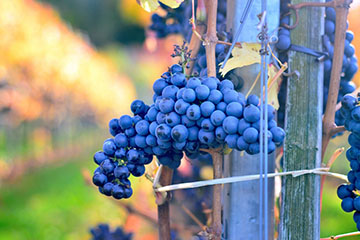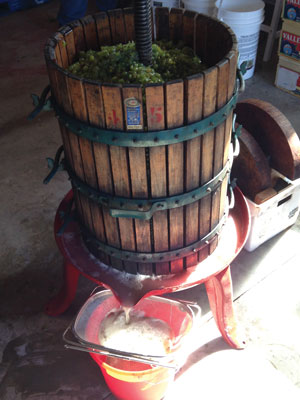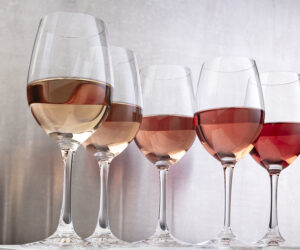
How ripe your grapes are when picked is one of the most important factors in determining what your wine will taste like. Delicious wines of drastically different styles can be made from the exact same vines, simply as a result of harvest time (viticultural practices make a big difference as well). From a consumer perspective, you can see production trends these days shifting from the very ripe styles of the 90s and 2000s (big, lush, powerful wines), to much less ripe offerings (lighter, fresher, elegant wines), with many of these lighter wines being produced from the same vineyards that their bigger counterparts come from. As a home winemaker (and often as a commercial one), if you are purchasing grapes, pick time may be the one factor in the vineyard you can control, and, thankfully, it is a huge one!
This article is a journey in the life of a grape from under- to over-ripeness. From bright fruit to dark, earth to opulence, pyrazines to field oxidation. All grapes develop in their own ways, so to an extent these are generalizations that may not always be the case for all grapes of all sites, but it is a solid guide, aiming to help you harvest at the moment that will be most parallel with your stylistic goals as a winemaker.
Let’s get something out in the open here: The concept of ripeness is a moving target, and, quite frankly, a bit of a mess! Ripeness does not progress in a simple linear fashion. All of the different factors that determine ripeness develop somewhat, or entirely, independently of one another, and each will have a different pace every year. Vineyard management practices will also affect the pace of many factors. Sugar levels, acidity levels, and grape taste are the most common parameters used to decide when to pick, but there are many more — 20 worth considering, according to the insightful Winegrape Berry Assessment Handbook by Winter, Whiting, and Rousseau!
If you’re growing your own grapes, you’re able to pick at will, and micromanagement of any and all ripening variables is an option. For the rest of us who are purchasing grapes, however, Brix and, perhaps, acidity levels will likely be the only indicators of ripeness we will receive prior to requesting a harvest date. That being the case, understanding the grape variety and site is crucial to understanding how “ripe” the grapes will be (and how close they will be developmentally) relative to those numbers — which, to be clear, are very important numbers, but do not tell the entire story.
For example, a Chardonnay picked at 21 °Brix in a hot climate will be very different than that of a cool climate: The hot climate will be well into tropical aromatics with lower acid, whereas the cool climate will remain on the stony and citric side and contain more acid. In the same vein, a Chardonnay picked at 3.1 pH in the hot climate would likely be grossly underripe and green, with very low sugars, whereas the cool climate may be well developed with reasonable sugar levels. Understanding where the different ripening variables will be relative to one another for a grape in a specific climate is paramount to picking at the moment that will lead to the wine you want.
The same goes for vintage variation, although you cannot completely control the pace of the many ripening variables (and vertical tastings would be boring if you could!), you can choose to pick earlier or later, aiming to keep the wine in line with your style goals and for what would be best for that vintage.
A factor I rarely hear discussed, and one I consider of the utmost importance to pick decisions, is the stage of aromatic development of the grape at the time of picking. This, of course, is not a factor that can currently be measured and is also one of the only factors that cannot be directly manipulated post-harvest. Brix, acidity levels, tannin, and color can all be measured, as well as manipulated after harvest. Beyond what the grape provides, aromatics can only be imprecisely tinkered with via yeast selection, added to with oak, or, especially in whites, use of enzyme preparations high in beta-glucosidases. The type of aromatics a grape will yield change tremendously during ripening, and, I believe, so does the degree to which a grape can express its individual terroir.
Of course, matching an appropriate grape variety to a vineyard site is critical in growing grapes in which ripeness characteristics will come together harmoniously in most years. In vintages or areas where they do not, the aforementioned manipulations or additions may be necessary.
From Veraison to Raisin
Just before veraison — the French term for the onset of ripening, when grapes soften and begin to take on their eventual color — a grape is intensely acidic and bitter, lacking sweetness, hard, and not particularly aromatic. Green tasting pyrazines are at their most concentrated and powerful at this moment. From a grape’s standpoint, its tasting this way is a great idea: Your seeds aren’t yet viable and ready to create a new vine, so tasting terrible discourages potential seed dispersing fauna from eating you until your seed is ready to create a new vine (this is an instance where green means stop and red means go!). Seeds are the first part of the grape to mature (which, in the seed’s case, means its viability), and this happens just before veraison begins.
The time between veraison and harvest is usually between one and two months. Heat spikes can cause great jumps in sugar accumulation, especially in varieties like Pinot Noir, particularly in later stages of ripeness. On the other hand, cold spells can easily add weeks, stalling sugar accumulation and, depending on the temperature, slowing acid loss and overall grape development. After the onset of veraison, if still picked “underripe,” prior to pyrazine and acid loss, as well as tannin maturation, a wine will most likely have green, vegetal aromas, and be unpleasantly acidic and bitter. If you’ve ever tasted a grape in this stage of development, it is not a flavor that quickly leaves the mouth or memory.
At the beginning of reasonable ripeness, white wines (roughly 19.5–22 °Brix, 3.0–3.3 pH) will generally have more citric, floral, “mineral,” or stony aromas, and in reds (roughly 21–24 °Brix, 3.3+pH) more earthy, meaty, herbal, and berry aromas. Grapes picked at this point have a more diverse aroma profile than most wines picked on the riper end of the spectrum, where complexities progressively become more fruit dominated. These wines will often have lighter bodies, be more lean (the opposite of fat) and “angular,” and may have more astringent tannins in their youth. Stylistically, these are the types of wines people refer to as “Old World.” They can be more elegant and finesse-focused and may show best at the dinner table (in part due to higher acid levels), whereas riper grapes would more likely yield “New World” wines that are bolder and fuller, lusher and more powerful, and show best on their own. These earlier picked wines will be in the 12–14% alcohol range. Some may disagree, but I am of the opinion that wines in this ripeness range usually demonstrate best the effects of their origins (terroir).
At these earlier levels of ripeness, certain grapes — think the Sauvignon family — can still have higher pyrazine levels. This is an instance where weather and vineyard management — specifically leaf removal in the fruit zone — can make or break a vintage; ensuring grapes have had sufficient light and heat exposure to get pyrazines to the desired level is crucial. At equivalent levels of ripeness, Chardonnay, for example, in most climates will have negligible amounts of pyrazines, whereas Sauvignon Blanc may remain too green without
cultural intervention.
Tannins at earlier stages of ripeness are less polymerized, and therefor more bitter (and less astringent), and seed tannins (smaller and more bitter) are more extractable as well. This means tannins in earlier stages of berry development are more aggressive, and wines may need a longer time to age both in barrel and bottle before being ready to drink. In the same way, cold vintages versus warm vintages may need the same treatment — more and less time to age prior to readiness, respectively — as the tannins will be less developed/polymerized in cooler years, and more in warmer years.
At further levels of ripeness in whites (roughly 22–24 °Brix, 3.4–3.6 pH), the citric, floral, and stony aromas metabolize into more tropical aromas. For reds (roughly 24–25 and 3.5+ pH), the range of aromas becomes increasingly fruit dominated. Earth and herbaceous aromas turn into cherry, plum, and darker fruit and spice aromas.
Malic acid declines as ripening progresses (in some varieties like Mourvèdre, pH quickly shoots up relative to sugar accumulation), leading to the perception of weight. (Higher glycerol production is often thought to have the same effect; however, concentrations higher than what is found in wine would be necessary for the presumed effect). A larger diurnal shift (a larger shift in temperature from day to night) helps retain acidity, but does not have the same effect on the pace of aroma development. The higher sugar levels mean higher alcohol levels, which, together with the fruitier aroma profile, can make a wine taste sweet. Both lower acid and higher alcohol may hinder a wine’s versatility at the table, but it is also what makes them much easier to enjoy on their own.
Acid loss — as well as aroma development and loss — can be slowed rel-ative to the other ripening variables by creating more shade in the fruit zone. By having more shade on clusters, either by less leaf pulling above the fruit or by various vine training forms, grapes retain a pH of 0.1 or 0.2 lower at the time of harvesting. Additionally, this is a great way to slow the development of aromatic compounds/precursors (for example, keep them in the citric/floral or earthy end of the spectrum longer), as well as to retain more of them, especially in reds. Aromatic compounds and precursors reach their greatest concentration prior to that of phenolic maturity in grapes, and this technique can help to narrow the time gap between them. Of note, color development in the vast majority of grape varieties is not affected by sunlight, so this would not decrease color concentration.
At the more extreme end of ripeness (26+ °Brix), grapes often begin to dehydrate (raisin), and it is at this point that “overripe” and dried fruit character enter the picture. Wines this ripe are usually very lush, soft, and have a pronounced perception of sweetness and weight.
Particularly in the New World, if a wine will be 15% alcohol or higher, watering back the wine to reduce the alcohol percentage is common. Some producers, seeking this profile, may choose to leave their grapes on the vine until heavily raisined, reaching 30+ °Brix (this is due to water evaporation in the grape, as opposed to continued sugar production by the leaves, which may have fallen off at this point), watering back before beginning fermentation to more typical sugar levels (and levels that won’t kill the yeast before they finish their job).
This is as valid a stylistic choice as any, but from a structural or winemaking standpoint, grapes this ripe can prove problematic. More and more anthocyanins become oxidized while still in the grape (this is known as “field oxidation”) from the extended hangtime. This means fewer and fewer anthocyanins can polymerize with tannins, therefore lower amounts of stable anthocyanins and tannins, leading to a wine that is fruit-forward and ready to drink young, but which will also see early browning, early tannin precipitation, and therefore a shorter life for the wine.
There are beautiful wines made in these ripeness levels from all over the world, though I personally feel at this level of ripeness much of what was unique about grapes from a particular site has been lost. Generic ripe fruit character takes over, and wines from very different origins and grapes taste fairly homogenous. Differences in processing and oak selections become more important quality differentiators. Philosophically speaking, I believe wines at these levels of ripeness are more a product of processing and winemaking than the fruit and vineyard site themselves (I’m reminded here of Randall Grahm’s lectures on “vin d’effort” versus “vin du terroir”). Acidity is greatly diminished and where a higher pH would be less of a concern for a wine with a sturdy structure, much more able to absorb oxygen, it means a wine is at even greater risk for microbial attack.
Trying to decide when to pick? Head to your local wine shop. In this day and age, it should be easy to find versions of the same grape at different ripeness levels, perhaps even from the area you are sourcing or growing your grapes.
To compare apples to apples, it would be ideal to try at least two wines from the same vineyard and vintage, from producers of different styles (more and less ripe). Though this will likely be fairly expensive, as single vineyard bottlings from desired vineyards rarely come cheap. Another more economical option would be two Old World wines (where it is easier to find higher quality wines at a lower price point) from the same region and vintage, made in different styles. Ask the salesperson at your favorite shop to guide you toward two that contrast each other, one riper, one less ripe. Watch out for heavily oaked wines, as heavy oak influence would add another variable, making the effect on fruit ripeness less apparent.
Although not always possible to make the exact style of wine you want to make from the grapes you have access to, viticultural practices, winemaking techniques, and the all important moment of pick are powerful ways to goad style in the desired direction. The more familiar you become with a grape variety, vineyard, and region, the more complete a picture you will see from the information you are given.






